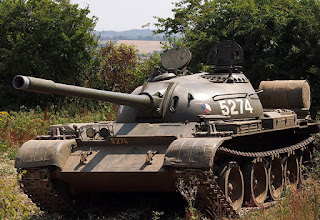Tanks Military
The serial production version, designated T-54-1, differed from the second T-54 prototype. It had thicker hull armour (80 mm on the sides, 30 mm on the roof and 20 mm on the bottom). As production ramped up, quality problems emerged. Production was stopped and an improved T-54-2 (Ob'yekt 137R) version was designed. Several changes were made and a new turret was fitted. The new dome-shaped turret with flat sides was inspired by the turret from the IS-3 heavy tank; it is similar to the later T-54 turret but with a distinctive overhang at the rear. It also had a shorter bustle.
The T-54 and T-55 tanks are a series of Soviet main battle tanks introduced in the years following the Second World War. The first T-54 prototype was completed at Nizhny Tagil by the end of 1945. Initial production ramp up settled for 1947 at Nizhny Tagil, and 1948 for Kharkiv were halted and curtailed as many problems were uncovered; the T-34-85 still accounted for 88 percent of production through the 1950s. The T-54 eventually became the main tank for armoured units of the Soviet Army, armies of the Warsaw Pact countries, and many others. T-54s and T-55s have been involved in many of the world's armed conflicts since the later part of the 20th century.
 The T-54/55 series eventually became the most-produced tank in military history. Estimated production numbers for the series range from 86,000 to 100,000. They were replaced by the T-62, T-64, T-72, T-80 and T-90 tanks in the Soviet and Russian armies, but remain in use by up to 50 other armies worldwide, some having received sophisticated retrofitting.
The T-54/55 series eventually became the most-produced tank in military history. Estimated production numbers for the series range from 86,000 to 100,000. They were replaced by the T-62, T-64, T-72, T-80 and T-90 tanks in the Soviet and Russian armies, but remain in use by up to 50 other armies worldwide, some having received sophisticated retrofitting.
During the Cold War, Soviet tanks never directly faced their NATO adversaries in combat in Europe. However, the T-54/55's first appearance in the West around the period of the 1950s (then the beginning of the Cold War) spurred the United Kingdom to develop a new tank gun, the Royal Ordnance L7, and the United States to develop the M60 Patton.
Production of the initial series of T-54s began slowly as 1,490 modifications were made. The Red Army received a tank that was superior to World War II designs and theoretically better than the newest tanks of potential opponents. The 100 mm gun fired BR-412 series full-calibre APHE ammunition, which had superior penetration capability when compared to the T-34 that it replaced.
 The T-54/55 series eventually became the most-produced tank in military history. Estimated production numbers for the series range from 86,000 to 100,000. They were replaced by the T-62, T-64, T-72, T-80 and T-90 tanks in the Soviet and Russian armies, but remain in use by up to 50 other armies worldwide, some having received sophisticated retrofitting.
The T-54/55 series eventually became the most-produced tank in military history. Estimated production numbers for the series range from 86,000 to 100,000. They were replaced by the T-62, T-64, T-72, T-80 and T-90 tanks in the Soviet and Russian armies, but remain in use by up to 50 other armies worldwide, some having received sophisticated retrofitting.During the Cold War, Soviet tanks never directly faced their NATO adversaries in combat in Europe. However, the T-54/55's first appearance in the West around the period of the 1950s (then the beginning of the Cold War) spurred the United Kingdom to develop a new tank gun, the Royal Ordnance L7, and the United States to develop the M60 Patton.
Production of the initial series of T-54s began slowly as 1,490 modifications were made. The Red Army received a tank that was superior to World War II designs and theoretically better than the newest tanks of potential opponents. The 100 mm gun fired BR-412 series full-calibre APHE ammunition, which had superior penetration capability when compared to the T-34 that it replaced.
The fender machine guns were removed in favour of a single bow-mounted machine gun. The transmission was modernized and the track was widened to 580 mm. The T-54-2 entered production in 1949, at Stalin Ural Tank Factory No. 183 (Uralvagonzavod). In 1951, a second modernization was made, designated T-54-3 (Ob'yekt 137Sh), which had a new turret without side undercuts, as well as the new TSh-2-22 telescopic gunner's sight instead of the TSh-20. The tank featured the TDA smoke generating system. A command version was built, the T-54K (komandirskiy), with a second R-113 radio. More details
